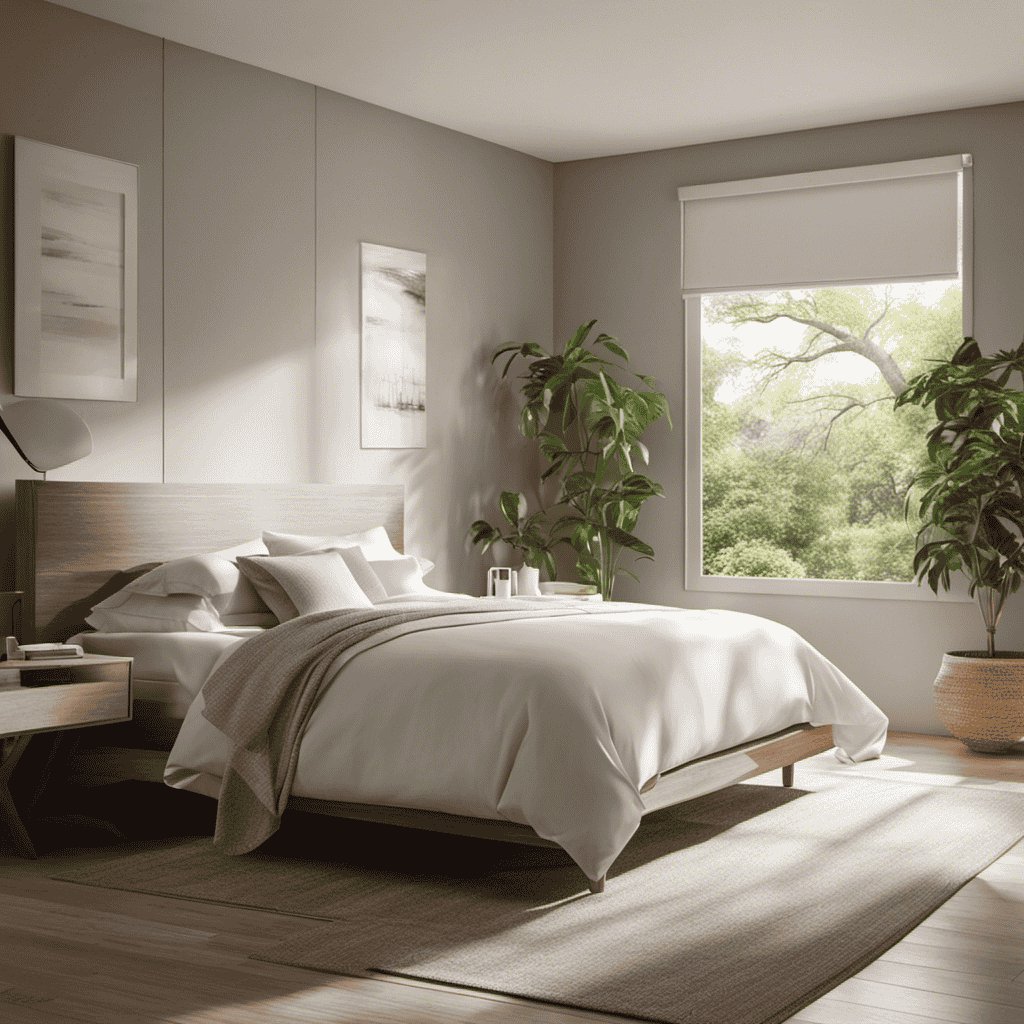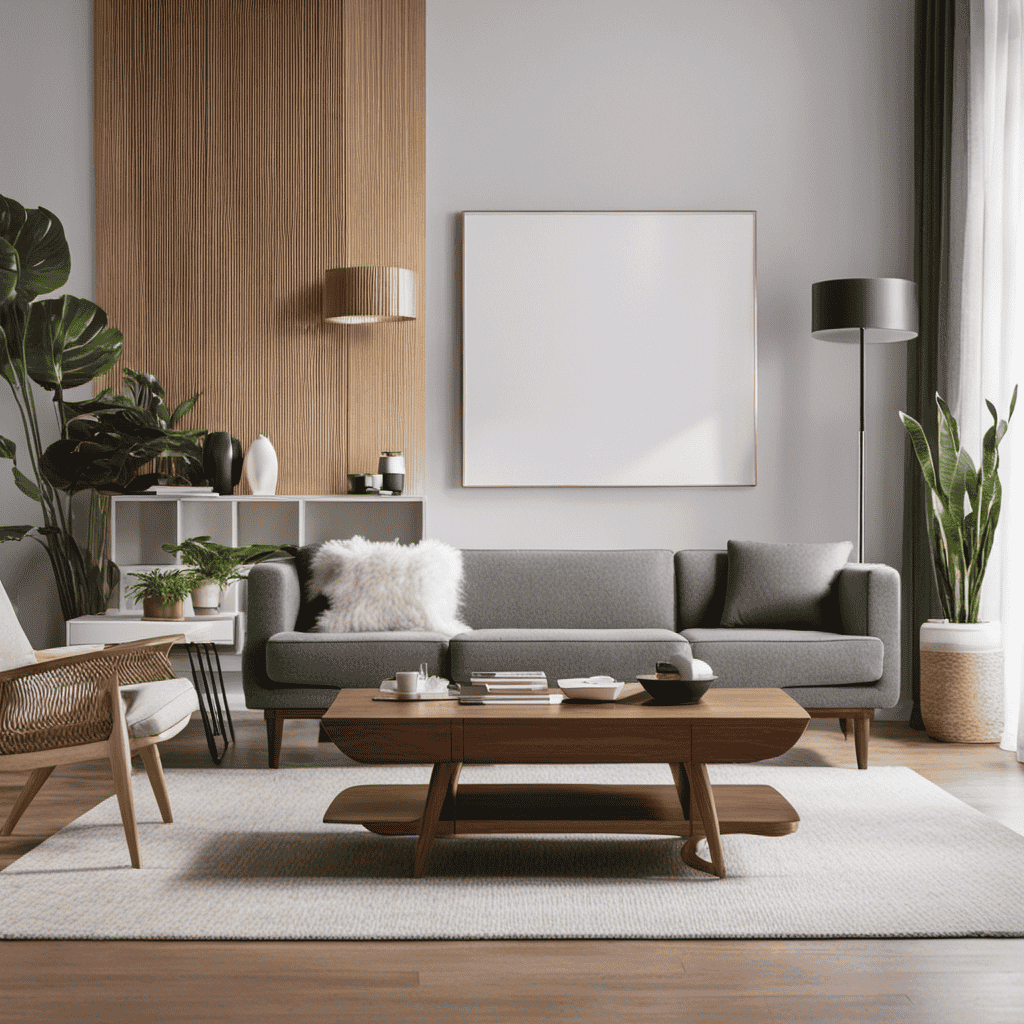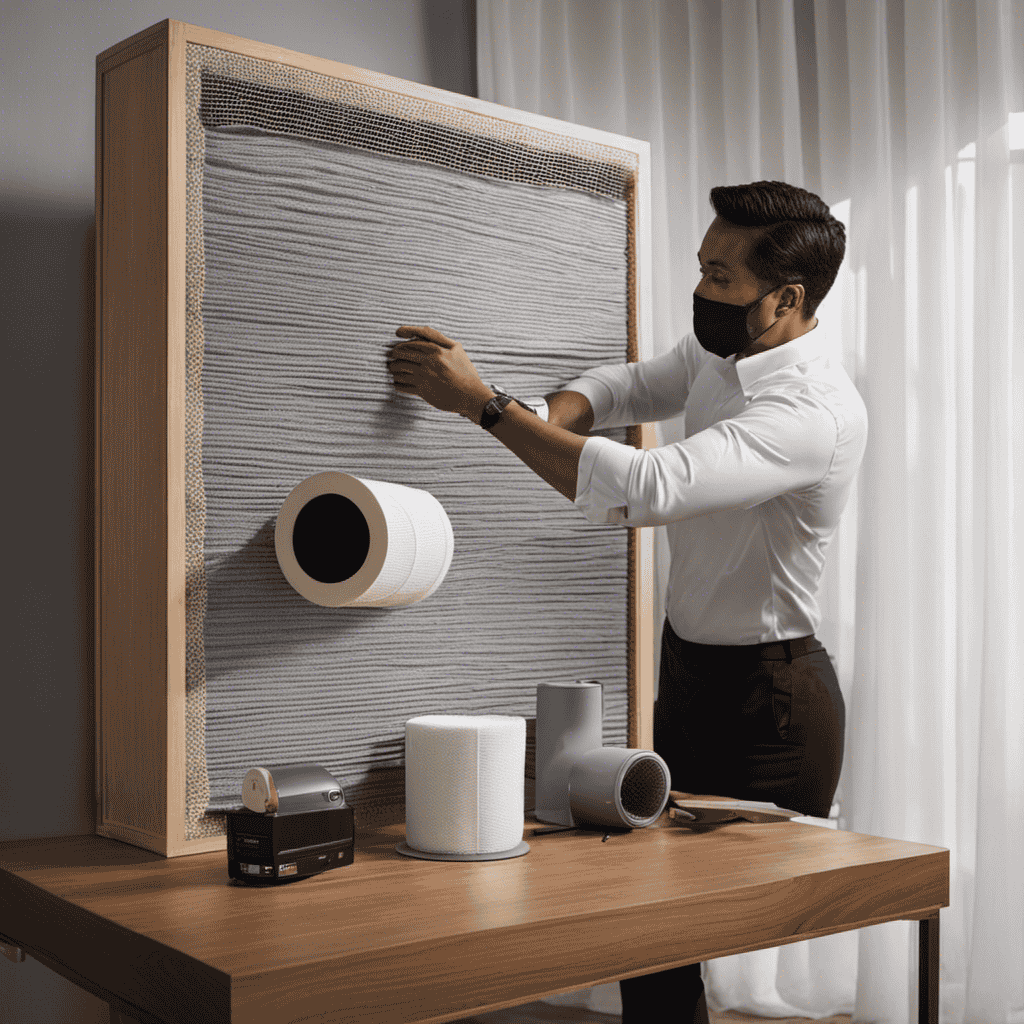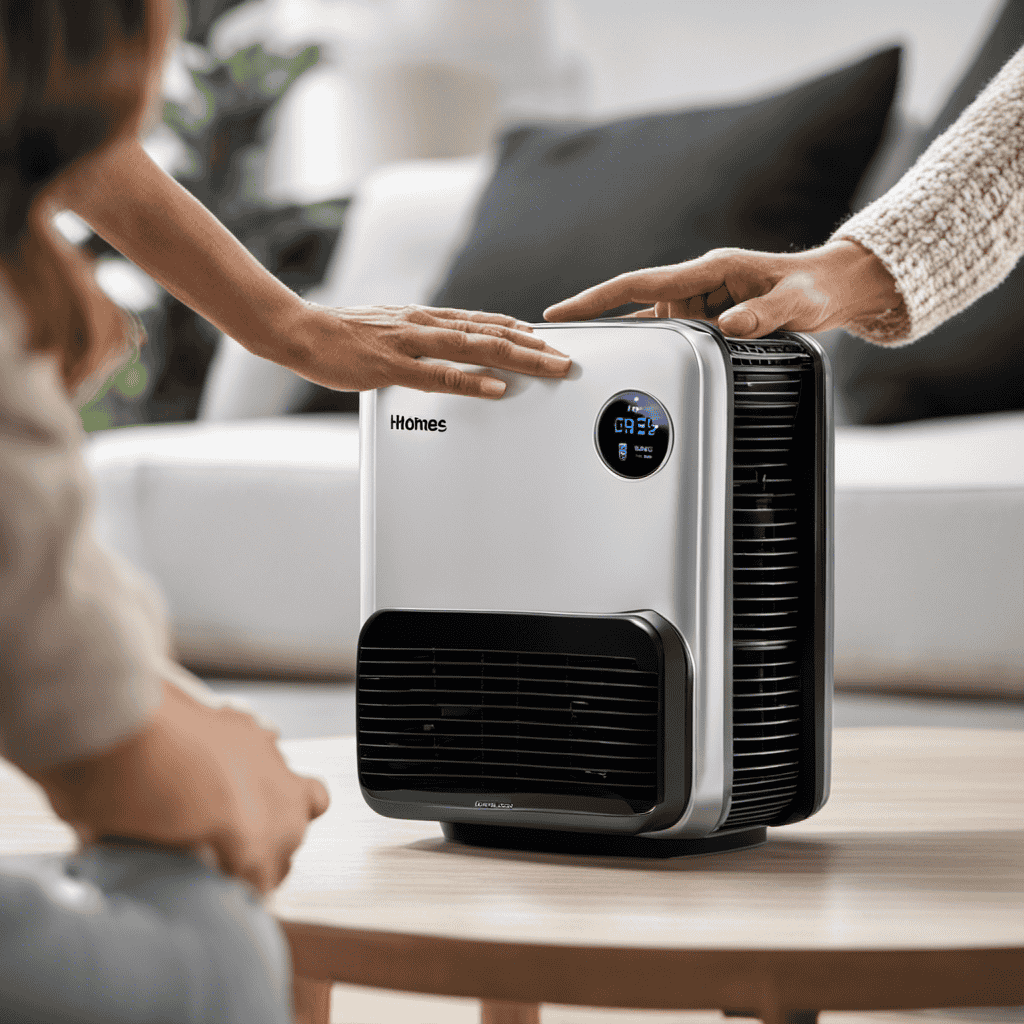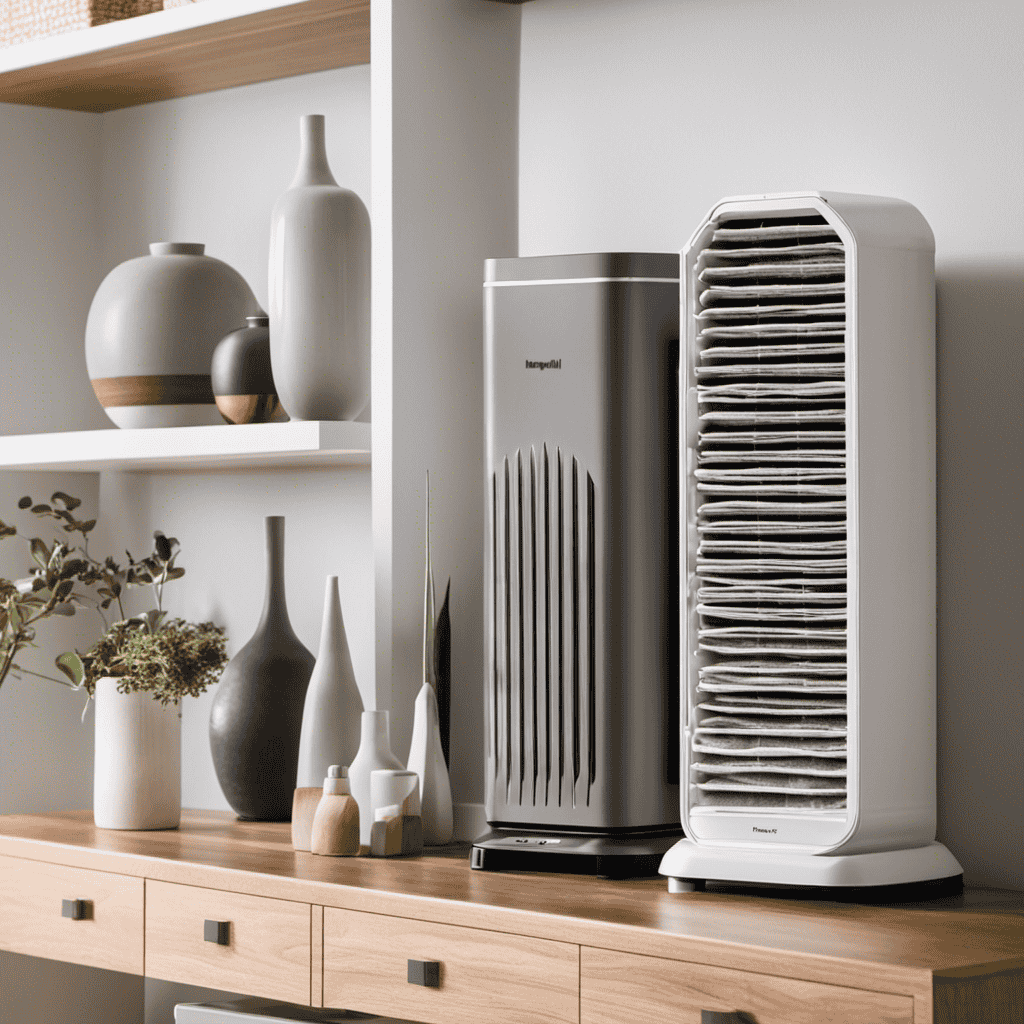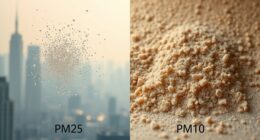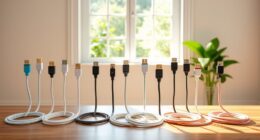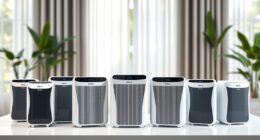I understand your hesitation – do you truly require an air purifier? Let me assure you, after conducting my own research, I was pleasantly surprised by the advantages that these devices offer.
Air purifiers are designed to improve indoor air quality by removing common pollutants and allergens. Not only can they help with respiratory issues, but they also contribute to a healthier living environment overall.
So, if you’re concerned about the air you breathe, stick around and let’s explore the purpose of an air purifier together.
Key Takeaways
- Air purifiers improve indoor air quality by removing pollutants and allergens.
- They help reduce respiratory symptoms and improve sleep quality.
- Air purifiers effectively remove harmful chemicals, odors, and volatile organic compounds (VOCs).
- Regular maintenance is crucial for optimal performance and longevity of air purifiers.
Understanding the Basics of Air Purifiers
Understanding the basics of air purifiers is essential for knowing how they can improve indoor air quality. There are many different brands of air purifiers available on the market, each with their own unique features and technologies.
When it comes to air purifier maintenance, it is important to regularly clean or replace the filters to ensure optimal performance. Filters capture particles such as dust, pollen, pet dander, and smoke, reducing the amount of these pollutants in the air. By removing these contaminants, air purifiers can help improve indoor air quality, making it cleaner and healthier to breathe.
Additionally, some air purifiers are equipped with advanced features like UV-C light, which can help eliminate bacteria and viruses from the air. With proper maintenance and regular use, air purifiers can make a significant difference in the quality of the air we breathe.
Moving on to how air purifiers improve indoor air quality…
How Air Purifiers Improve Indoor Air Quality
To improve your indoor air quality, you’ll want to know how air purifiers work and what benefits they offer.
Air purifiers are designed to remove pollutants and allergens from the air, effectively improving the overall air quality in your home. They work by using filters or other technologies to capture and trap particles such as dust, pollen, pet dander, and mold spores.
By eliminating these contaminants, air purifiers can reduce respiratory symptoms like sneezing, coughing, and congestion. Additionally, air purifiers can also help improve sleep quality by creating a cleaner and healthier environment. When the air is free from irritants and pollutants, it can promote better breathing and reduce nighttime allergies, leading to a more restful sleep.
Overall, air purifiers play a crucial role in maintaining a healthy indoor environment and enhancing well-being.
Common Air Pollutants Removed by Air Purifiers
When using an air purifier, you’ll notice a significant reduction in common pollutants like dust, pollen, pet dander, and mold spores. These pollutants can cause various health issues such as allergies, respiratory problems, and asthma attacks.
Here are some common air pollutants that air purifiers effectively remove:
- Volatile Organic Compounds (VOCs): These are chemicals emitted by household products like cleaning supplies, paints, and furniture.
- Tobacco Smoke: Air purifiers can filter out the harmful chemicals and particles present in tobacco smoke.
- Bacteria and Viruses: Air purifiers with HEPA filters can capture and remove these harmful microorganisms from the air.
- Odors: Air purifiers can help eliminate unpleasant smells caused by cooking, pets, or chemicals.
- Formaldehyde: Found in building materials, air purifiers can effectively reduce the levels of this harmful chemical.
The Health Benefits of Using an Air Purifier
Using an air purifier can improve respiratory health, reduce allergy symptoms, and create a cleaner living environment. Air purifiers work by removing harmful particles and contaminants from the air, helping to reduce the risk of respiratory issues such as asthma and allergies. They can also help to alleviate symptoms by removing allergens like pollen, dust mites, and pet dander. Additionally, air purifiers can remove odors, smoke, and volatile organic compounds (VOCs) from the air, creating a fresher and cleaner living space. The impact of air purifiers on respiratory health is significant, as they can reduce the amount of airborne pollutants that we breathe in on a daily basis. By providing cleaner air, air purifiers can help improve overall respiratory function and promote better health.
| Air purifier benefits | Impact on respiratory health |
|---|---|
| Removes harmful particles | Reduces risk of respiratory issues |
| Alleviates allergy symptoms | Removes allergens like pollen, dust mites, and pet dander |
| Removes odors, smoke, and VOCs | Creates a fresher and cleaner living space |
| Provides cleaner air | Improves overall respiratory function |
| Promotes better health |
Choosing the Right Size Air Purifier for Your Space
It’s important to choose the right size for your space when selecting an air purifier. The size of the air purifier will determine its effectiveness in cleaning the air in your room. Here are some guidelines to help you determine the appropriate size for your space:
- Consider the square footage of the room: A larger room will require a more powerful air purifier to effectively clean the air.
- Look at the Clean Air Delivery Rate (CADR): This rating indicates how well the air purifier can filter out pollutants. Choose a purifier with a CADR that matches the size of your room.
- Consider the height of the ceiling: If you have high ceilings, you may need a larger air purifier to effectively circulate and clean the air.
- Take into account the level of air pollution: If you live in an area with high pollution or have allergies, you may want to choose a larger air purifier for better filtration.
- Regular maintenance is key: Regardless of the size, all air purifiers require regular maintenance to ensure optimal performance.
Choosing the right size air purifier is crucial for maintaining clean and healthy indoor air.
Now that we’ve covered the importance of size, let’s explore the different types of air purifier technologies.
Different Types of Air Purifier Technologies
When it comes to air purifiers, there are two main types of technologies to consider: filters and ionizers. Filters work by trapping airborne particles, such as dust and pollen, while ionizers release charged particles that attach themselves to pollutants, causing them to settle.
Another technology that can be effective in eliminating bacteria is UV-C light, which damages the DNA of bacteria, viruses, and other microorganisms, preventing them from reproducing.
In this discussion, I will explore the pros and cons of filter versus ionizer technology, as well as the effectiveness of UV-C light in combating bacteria.
Filter Vs. Ionizer
The main difference between a filter and an ionizer is the way they remove pollutants from the air. A filter works by trapping particles in a fibrous material, effectively removing them from the air.
On the other hand, an ionizer uses ionization technology to charge particles in the air, causing them to stick to surfaces or attach to a collector plate.
Here are some key points to consider when comparing filter and ionizer technologies:
-
Filter maintenance: Filters need to be replaced regularly to maintain their effectiveness, while ionizers require less maintenance but may need occasional cleaning of collector plates.
-
Particle removal: Filters can capture both large and small particles, including allergens and airborne contaminants, whereas ionizers mainly target smaller particles.
-
Odor reduction: Filters are more effective in reducing odors, as they can trap odor-causing particles, while ionizers may only mask odors temporarily.
-
Noise level: Filters tend to be quieter compared to ionizers, which may produce a low humming sound.
-
Energy consumption: Filters typically consume more energy, especially if they have a fan, while ionizers consume less energy overall.
Understanding the differences between filters and ionizers can help you choose the air purifier that best suits your needs.
Now, let’s explore the effectiveness of UV-C technology in eliminating bacteria.
UV-C for Bacteria?
To effectively eliminate bacteria, you can consider using UV-C technology in your air purification system. UV-C, also known as Ultraviolet Germicidal Irradiation (UVGI), is a proven method for killing bacteria and other microorganisms. It works by emitting short-wavelength ultraviolet light that damages the DNA and RNA of bacteria, preventing them from reproducing and causing harm. UV-C technology has been extensively studied and has shown great effectiveness in reducing bacterial contamination in various settings, including hospitals, laboratories, and homes.
In fact, UV-C technology is not only effective against bacteria, but it is also highly effective against viruses. Research has shown that UV-C light can inactivate a wide range of viruses, including coronaviruses. This makes UV-C technology an excellent choice for air purifiers, especially in times when viral infections are a concern.
Here is a table summarizing the effectiveness of UV-C technology in eliminating bacteria and viruses:
| Microorganism | Effectiveness of UV-C Technology |
|---|---|
| Bacteria | High |
| Viruses | High |
| Mold | Moderate |
| Dust mites | Low |
| Allergens | Low |
Overall, incorporating UV-C technology in your air purification system can provide an additional layer of protection against bacteria and viruses, ensuring cleaner and healthier air in your indoor environment.
The Role of HEPA Filters in Air Purifiers
If you want cleaner air in your home, you should consider getting an air purifier with a HEPA filter. HEPA, which stands for High Efficiency Particulate Air, is a type of filter that can capture tiny particles in the air, such as dust, pollen, pet dander, and even some bacteria and viruses.
Here are some important things to know about HEPA filters:
-
HEPA filter lifespan: On average, a HEPA filter can last anywhere from 6 months to 2 years, depending on the brand and usage. It is important to check the manufacturer’s recommendations for replacement.
-
Regular maintenance: To ensure optimal performance of your HEPA filter, it is crucial to clean or replace it regularly. This can involve vacuuming the filter or washing it, depending on the type.
-
Avoid moisture: HEPA filters are not designed to handle moisture or water. It is important to keep them away from humid areas to prevent mold growth.
-
Monitor air quality: Regularly check the air quality in your home to determine when the filter needs cleaning or replacement. Some air purifiers come with built-in air quality monitors for convenience.
-
Follow manufacturer’s instructions: Always refer to the manufacturer’s instructions for specific maintenance tips and guidelines for your air purifier model. This will ensure that you are properly maintaining your HEPA filter and extending its lifespan.
How Air Purifiers Help With Allergies and Asthma
Air purifiers play a crucial role in providing relief from allergies. They purify the air and remove allergens such as dust, pollen, and pet dander. By effectively filtering out these particles, air purifiers reduce their presence in the air and minimize the risk of allergic reactions.
Another benefit of air purifiers is their ability to help manage asthma symptoms. They remove asthma triggers like mold spores, smoke, and volatile organic compounds (VOCs) from the air. This creates a cleaner and healthier environment for individuals with asthma.
In this way, air purifiers not only combat allergens and asthma triggers but also contribute to overall respiratory health.
Allergy Relief Through Purification
You’ll find relief from allergies by using an air purifier. Air purifiers are designed to remove allergens from the air, reducing your exposure to irritants that can trigger allergy symptoms.
Here are some key points to consider about allergen reduction and air purifier maintenance:
- Regularly clean or replace the air filters in your purifier to ensure optimal performance.
- Look for purifiers with high-efficiency particulate air (HEPA) filters, as they can capture small particles like pollen, dust mites, and pet dander.
- Consider additional features like activated carbon filters, which can help remove odors and chemicals from the air.
- Place the purifier in the rooms where you spend the most time to maximize its effectiveness.
- Keep windows and doors closed to prevent outdoor allergens from entering your home.
By using an air purifier to reduce allergens in your environment, you can experience significant relief from allergy symptoms.
Now let’s explore how air purification can also help with asthma management.
Asthma Management via Purification
To effectively manage your asthma, consider utilizing the benefits of purification through an air purifier. Asthma triggers can be found in our everyday environment, such as dust mites, pet dander, pollen, and mold spores. These triggers can exacerbate asthma symptoms and make it difficult to breathe. Air purification techniques can help remove these triggers from the air, providing relief and improving indoor air quality.
Here is a table highlighting some common asthma triggers and the effectiveness of air purifiers in combating them:
| Asthma Trigger | Air Purification Technique | Effectiveness |
|---|---|---|
| Dust Mites | HEPA Filters | High |
| Pet Dander | Activated Carbon Filters | Moderate |
| Pollen | HEPA Filters | High |
| Mold Spores | UV-C Light | Moderate |
| Airborne Chemicals | Activated Carbon Filters | High |
Air Purifiers Combat Triggers
When it comes to managing asthma symptoms, air purifiers can be incredibly beneficial. They work by removing harmful particles from the air, such as dust, pollen, and pet dander, which are common triggers for asthma attacks. Not only can air purifiers improve indoor air quality, but they can also reduce the presence of allergens and irritants that can worsen asthma symptoms.
Air purifiers are highly effective in combating asthma triggers for several reasons:
- Filtration: Air purifiers use filters to trap and remove allergens and pollutants from the air.
- Purification: They can remove up to 99.97% of airborne particles, including those that can trigger asthma attacks.
- Continuous cleaning: Air purifiers work constantly to keep the air clean, ensuring a healthier environment.
- Quiet operation: Most air purifiers operate silently, allowing you to sleep or work without disturbance.
- Easy maintenance: Regularly changing the filters in air purifiers is a simple task that helps maintain their effectiveness.
Eliminating Odors With Air Purifiers
Don’t underestimate how effective air purifiers can be at getting rid of unpleasant odors.
Air purifiers are designed to remove and neutralize various types of odors, including those caused by cooking and cigarette smoke.
When it comes to cooking smells, air purifiers work by filtering the air and capturing the volatile organic compounds (VOCs) that are released during the cooking process. These VOCs are responsible for the lingering smells in the air.
Similarly, air purifiers can effectively remove the smell of cigarette smoke by filtering out the harmful particles and chemicals present in the smoke. The filters in air purifiers are specifically designed to trap and eliminate these odors, ensuring that the air in your home remains fresh and clean.
Air Purifiers and Pet Dander: What You Need to Know
If you have pets, it’s important to know that air purifiers can effectively remove pet dander from the air in your home. Pet dander, which consists of tiny particles of skin and hair, can trigger allergies in some people. Air purifiers work by filtering the air and capturing these particles, reducing the allergens in the environment.
Here are some key points to consider:
- Air purifiers with HEPA filters are highly effective in removing pet dander from the air.
- HEPA filters can capture particles as small as 0.3 microns, including pet allergens.
- Make sure to choose an air purifier with a sufficient CADR (Clean Air Delivery Rate) for the size of your room.
- Regular maintenance, such as cleaning or replacing the filters, is essential for optimal performance.
- Air purifiers can also help alleviate symptoms caused by pollen, another common allergen.
The Importance of Regular Maintenance for Air Purifiers
To keep your air purifier working effectively, it’s important to regularly clean or replace the filters. Proper maintenance is crucial for extending the lifespan of your air purifier and ensuring it continues to provide clean and fresh air.
Here is a maintenance checklist to help you keep your air purifier in optimal condition:
- Check the filter indicator regularly and replace the filters according to the manufacturer’s instructions.
- Vacuum or wipe down the exterior of the air purifier to remove dust and debris.
- Clean the pre-filter regularly to prevent it from becoming clogged.
- Use a soft brush or cloth to gently clean the fan blades to maintain proper airflow.
- Keep the air purifier in a well-ventilated area and avoid placing it near obstructions.
Noise Levels and Energy Efficiency of Air Purifiers
When it comes to air purifiers, noise levels can have a significant impact on their efficiency. Excessive noise can disrupt sleep and concentration, making it essential to consider the noise output of an air purifier before purchasing one.
Additionally, energy-saving air cleaners are designed to minimize power consumption while still effectively removing pollutants from the air, making them an eco-friendly and cost-effective choice.
Noise Impact on Efficiency
The noise from an air purifier can affect its efficiency. Excessive noise can hinder the purifier’s ability to effectively clean the air and reduce pollutants. Noise reduction is crucial for user satisfaction, as loud purifiers can be disruptive to daily activities and disturb sleep.
To ensure optimal efficiency, it is important to consider the noise levels of an air purifier before purchasing. Here are five key points to keep in mind:
- High noise levels can indicate a strained motor or clogged filters, which can negatively impact the purifier’s performance.
- Look for air purifiers with noise reduction technologies such as sound insulation, quiet mode, or low-noise fans.
- Consider the decibel rating of the air purifier and choose one that operates within an acceptable noise level for your needs.
- Regularly clean and maintain the purifier to prevent excessive noise caused by dust accumulation or mechanical issues.
- Read user reviews and ratings to get an idea of the noise levels and overall satisfaction of other customers.
Energy-Saving Air Cleaners
Consider opting for energy-saving air cleaners that can help reduce your electricity bill while still effectively cleaning the air in your space. Energy efficient air purifiers are designed to consume less energy while maintaining their cleaning performance. These devices use advanced technologies, such as low-power fans and efficient filters, to remove contaminants from the air without wasting excessive electricity.
Air Purifiers Vs. Humidifiers: What’s the Difference
Air purifiers and humidifiers have distinct functions, but they both contribute to improving indoor air quality. Air purifiers are designed to remove pollutants such as dust, pollen, pet dander, and smoke particles from the air.
On the other hand, humidifiers add moisture to the air, which can be particularly beneficial in dry climates or during the winter months when indoor air tends to become dry. Here are some benefits of using a humidifier:
- Relieves dry skin, nasal congestion, and dry throat
- Reduces the risk of airborne viruses and respiratory infections
- Helps alleviate symptoms of allergies and asthma
- Prevents wood furniture and musical instruments from cracking
- Creates a more comfortable living environment
While both air purifiers and humidifiers have their own advantages, it’s important to understand your specific needs and choose the right device accordingly.
Now, let’s explore the effectiveness of air purifiers for smoke and VOC removal.
Air Purifiers for Smoke and VOC Removal
When it comes to smoke elimination techniques and VOC filtration effectiveness, there are several factors to consider.
Smoke can be a challenging pollutant to remove from the air, requiring specialized techniques such as carbon filtration and ionization.
On the other hand, VOCs, or volatile organic compounds, can be effectively filtered using activated carbon filters, which are designed to trap and remove these harmful substances.
Understanding the different techniques and their effectiveness is crucial in choosing the right air purifier for smoke and VOC removal.
Smoke Elimination Techniques
One way to effectively eliminate smoke in a room is by using an air purifier. Air purifiers are designed to remove particles and pollutants from the air, including smoke particles.
Here are some tips for maintaining an air purifier and the importance of air quality on respiratory health:
- Regularly clean and replace filters to ensure optimal performance.
- Keep the air purifier in a well-ventilated area to allow for proper air circulation.
- Check for any signs of damage or malfunction and address them promptly.
- Consider using an air purifier with a HEPA filter, which can effectively capture smoke particles.
- Improve overall air quality by ventilating the room, reducing indoor smoking, and avoiding the use of harmful chemicals.
Maintaining clean air is vital for respiratory health, as poor air quality can lead to various respiratory issues such as asthma, allergies, and respiratory infections.
Now, let’s explore the effectiveness of air purifiers in filtering VOCs.
VOC Filtration Effectiveness
After discussing smoke elimination techniques, let’s now delve into the effectiveness of VOC filtration technology.
Volatile organic compounds (VOCs) are harmful gases emitted from various sources like cleaning products, paints, and furniture. Air purifiers equipped with VOC filtration technology are designed to remove these pollutants from the air we breathe. These air purifiers utilize specialized filters that are specifically designed to capture and neutralize VOCs, helping to improve indoor air quality.
The benefits of clean air cannot be overstated. Breathing in clean air can reduce the risk of respiratory issues, allergies, and other health problems associated with indoor air pollution. By effectively removing VOCs, air purifiers with VOC filtration technology contribute to creating a healthier and safer indoor environment for individuals and families alike.
Factors to Consider When Buying an Air Purifier
To make the best choice when purchasing an air purifier, you should consider factors such as the size of the room and your specific air quality needs. The size of the room is important because it determines the purifier’s coverage area. Additionally, you should consider the type of pollutants you want to remove from the air, whether it’s dust, pollen, pet dander, or smoke.
Some top air purifier brands to consider are:
- Honeywell
- Dyson
- Coway
- Blueair
- GermGuardian
These brands have a reputation for producing high-quality air purifiers that effectively clean the air. It’s also important to consider the noise level of the purifier, especially if you plan on using it in a bedroom or office.
Lastly, check for additional features such as a filter replacement indicator or a timer function. By considering these factors, you can ensure that you choose the right air purifier for your needs.
What Are the Benefits of Using an Air Purifier?
Air purifier uses in home are numerous. They can improve indoor air quality by removing allergens, pet dander, and odors. Additionally, air purifiers can help reduce respiratory issues and create a healthier living environment. With regular use, they can provide relief for asthma and allergy sufferers.
Frequently Asked Questions
Can Air Purifiers Remove Harmful Gases and Chemicals Like Vocs?
Yes, air purifiers can remove harmful gases and chemicals like VOCs. They work by using filters or other technologies to trap and remove these pollutants, improving indoor air quality and reducing allergy symptoms.
How Often Should I Replace the Filters in My Air Purifier?
When should I change the filters in my air purifier? It is important to regularly replace the filters to ensure optimal performance and maintain clean air quality. Frequency depends on usage and manufacturer recommendations.
Are There Any Potential Health Risks Associated With Using an Air Purifier?
There may be potential side effects and long-term effects associated with using an air purifier. These can vary depending on the individual and the specific purifier used. It’s important to research and choose a purifier that suits your needs and health concerns.
Can Air Purifiers Help With Specific Respiratory Conditions Like COPD or Lung Infections?
Air purifiers can be beneficial for respiratory conditions like COPD and lung infections. They help remove allergens and irritants from the air, reducing triggers for allergies and asthma. It’s important to choose the right type of purifier for specific needs.
Are There Any Specific Safety Precautions I Should Take When Using an Air Purifier?
When using an air purifier, it is important to follow safety precautions. Regular maintenance, such as cleaning or replacing filters, is necessary. I recommend researching reputable brands for the best air purifier options.
Conclusion
In conclusion, air purifiers play a crucial role in improving indoor air quality and enhancing our overall health and well-being. These devices remove common air pollutants such as dust, pollen, and pet dander, creating a cleaner and safer environment for us to breathe in. Additionally, the right size air purifier can effectively cover our space, while considering noise levels and energy efficiency.
So, if you’re looking to create a healthier living space, investing in an air purifier is definitely worth considering.
Stay tuned to uncover more fascinating insights about air purifiers and their impact on our lives.
